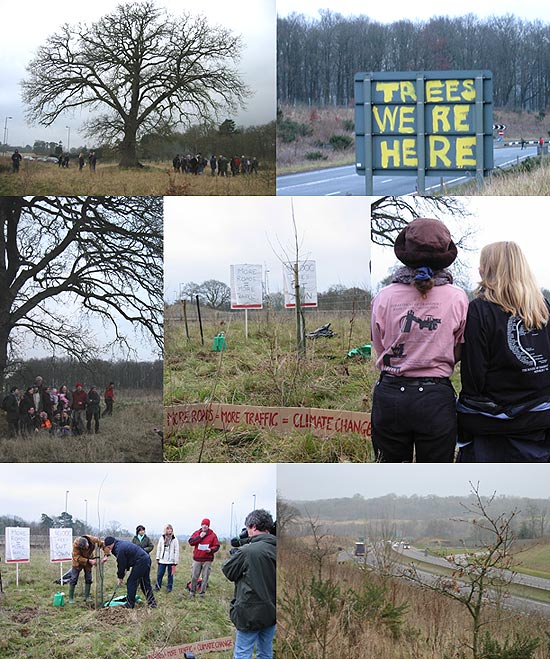It's ten years on Monday since the destruction of around 10,000 trees began in ernest, or rather should have done - back then protestors scored an early victory by blockading the entrance to the security compound with scaffolding tripods, thus ensuring no vehicles could leave. The start of work heralded the most full-on phase of the '3rd Battle of Newbury', Britain's biggest ever road protest, which saw over thirty different tree camps set up to oppose the road and around one thousand arrests.

Ten years on and the same issues are still there. Research over recent years and in particular last year has shown that the Bypass has fuelled traffic growth of almost 50% (compared with a national average of 5%). Figures also show that local congestion is as bad at rush hour as it was before the building of the bypass - and that the new road encouraged more traffic.
Rebecca Lush from Road Block said in a statement:
"In 1995 we predicted the road would bring only short term relief, but even we did not anticipate that the traffic would rise again so quickly. Ten years on we are sad to see Newbury is still grid locked at rush hour, but has sacrificed its beautiful pristine countryside forever. The lessons must be learned, that building more roads generates more traffic. However the government is still building roads and encouraging traffic growth. More roads mean more traffic, which means more climate change. We must change direction, and Newbury is an example of a failed twentieth century transport policy that must never be repeated".
The A34 Newbury Bypass was Britain's most controversial road-building project. Local campaigners battled against the road throughout the 1980s, their efforts culminating in a public inquiry in 1988 (with a minor follow-up inquiry in 1992). When the public inquiry found in favour of the road, there followed a spectacular campaign from 1994 to 1998 that took in every form of protest, from mass letter writing and European lobbying to mass non-violent direct action and property damage.
The building of the road saw four Sites of Special Scientific Interest damaged or destroyed at Snelsmore Common, the River Kennet, the River Lambourn and the Kennet Flood Plains (previously home to the Desmoulin's Whorl Snail, discovered during the construction of the road); as well as this the road construction also damaged the site of the First Battle of Newbury in the English Civil War in 1643, and the North Wessex Downs Area of Outstanding Natural Beauty.
Opposition to new road building, airport expansion and climate change continues today, both in the Uk and beyond - for more info see:
Road Block:
 http://www.roadblock.org.uk
http://www.roadblock.org.uk Road Alert:
 http://www.roadalert.org.uk
http://www.roadalert.org.uk ----------------------------
NEWBURY LINKS:
Newbury Bypass Resistance Archive:
 http://www.antiroads.org.uk/newbury/factfile.html
http://www.antiroads.org.uk/newbury/factfile.html SchNEWS on Start of Bypass Destruction 1995:
 http://www.schnews.org.uk/archive/news56.htm
http://www.schnews.org.uk/archive/news56.htm Newbury Bypass Monitoring Project:
 http://www.newburyproject.org.uk
http://www.newburyproject.org.uk West Berkshire District Council's Newbury Movement Study (published 2005):
 http://www.westberks.gov.uk/WestBerkshire/transport.nsf/pages/NewburyM114721.html
http://www.westberks.gov.uk/WestBerkshire/transport.nsf/pages/NewburyM114721.html Newbury Bypass on Wikipedia:
 http://en.wikipedia.org/wiki/Newbury_bypass
http://en.wikipedia.org/wiki/Newbury_bypass Road Raging: A Manual for Resisting Road Building:
 http://www.eco-action.org/rr/
http://www.eco-action.org/rr/ ----------------------------
Just a few great names of the many to remember... Mary Hare - Gotan - Snelsmore - Kennet - Reddings Copse - Sheep Dip - Heartb'k Hotel - Horse Shoe - Bagnor - Middle Oak - Granny Ash - Rickety Bridge - Tot Hill - Victor Charlie - Enborne St - Enborne Row - The Chase - Birthday Party - Skyward - Castlewood - PP3 - Babble Brook - Sea View - Manic Shire - Yip!

 e-mail:
e-mail:
 Homepage:
Homepage:
Comments
Display the following 3 comments